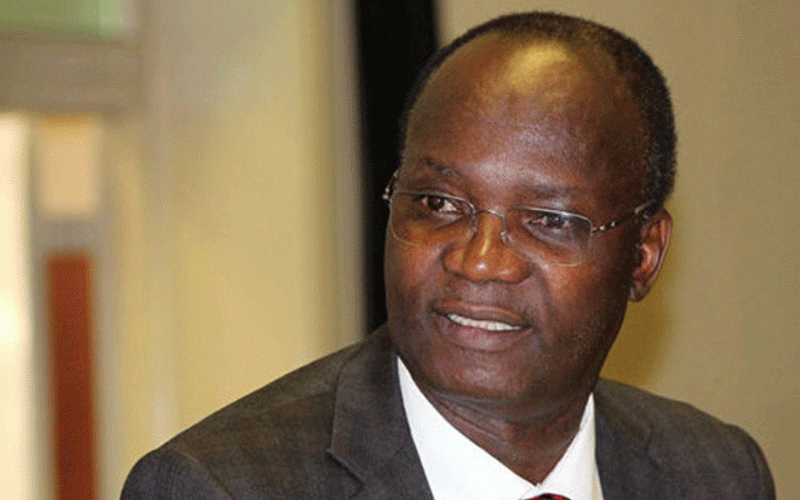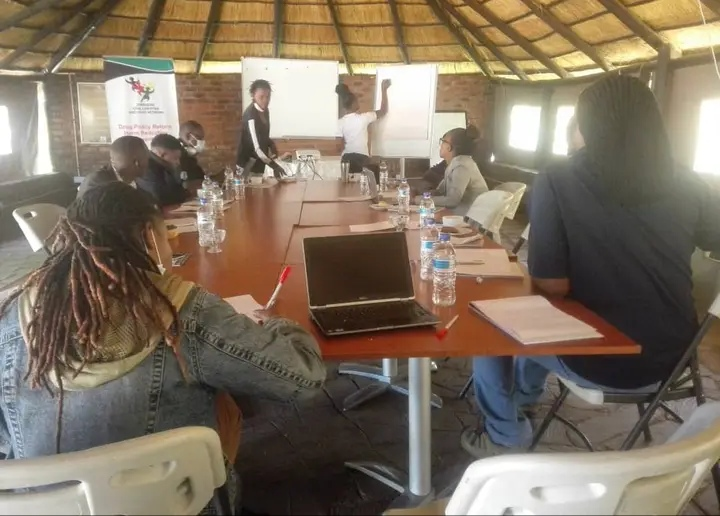
Politics? No! Music? Yes!
Did you know that Professor Jonathan Moyo the politician is/was also a musician?
Sometime back in 2001, Jonathan Moyo and I sat next to each other on the plane coming to Harare from Johannesburg. We discussed music. He told me that he had been to Tanzania and was impressed by that government’s policy of airplay where local Tanzanian musicians were given more time on the air than foreign ones. He told me that Zimbabwe should also adopt this policy as it benefited local musicians. He gave me a list of these benefits. He said: “Radio airplay may not be the only way for an artist to find widespread exposure. However, it remains a vital link in increasing their audience, and indeed attendance at shows, which also helps develop a larger fan base and increased sales. If our local radio stations implemented the idea of playing mainly local artistes, our musicians would definitely increase their income through wider sales of their records and bigger show attendances.” Prof., what do you think?”
He asked for my opinion. I agreed with him.
The next day, I went and told my Radio 3 DJ friend, Peter Johns, about our discussion. He was not impressed. Peter, at the time, used to spend a lot of his time following the American and British music charts. He also used to spend hundreds of US dollars of his own money on buying imported records from the US and from the UK. every week. These records made him the DJ that he became as no other DJ had access to them. He hardly played music from local artistes during his radio shows.
Many Radio 3 DJs at the time who included John Matinde, Josh Makawa, Admire Taderera, Tich Mataz, Kudzi Marudza, Kelvin Sifelani and Simon Parkinson all envied Peter Johns as they also used to play imported music which they carried in their bags to and fro the radio station. They were not very keen on local music which was supplied by the likes of Gramma Records, R.T. P. and Zimbabwe Music Corporation. Those with international connections used to have the ‘best’ playlists and would boast about it.
Now here comes Moyo. He became Zimbabwe government’s Information minister initially between 2000 and 2005 and later again in 2013. This appointment enabled him to make changes at Zimbabwe Broadcasting Corporation (ZBC) where the 75% local content in music which received airplay was implemented. This saw the birth of the Urban Grooves genre as local artistes who were into R&B saw it fit to emulate American rhythms and sing in Shona to make the genre sound local.
When Moyo became Information minister, many people accused him of banning radio DJs from playing international music which they were used to. Moyo said, “I hear you. But no professional radio station would allow DJs to carry their own beats and ignore their own local music which the station supplies. It’s terrible”.
- Uproar over Makandiwa’s corruption remarks
- Jonathan Moyo: Why we apologised to Zanu PF
- ED must act on despicable behaviour by supporters
- The year 2022 in politics
Keep Reading
The international music played on Zimbabwe’s radio stations also bled ZBC by creating a huge forex bill for royalties which were being paid out to foreign musicians through organisations such as the Confederation of International Songwriters, Authors and Composers (CISAC), British Music Incorporated (BMI) and Performance Rights Society (PRS). ZBC as a result went bust. They even had their vehicles attached by the messenger of court due to non-payment of royalties to foreign artistes.
Moyo is credited for pioneering 75% local content which saw the rise of many local artistes. During his tenure as the Information minister, Moyo introduced the 75 percent local content, which saw the emergence of the Urban Grooves genre and the rise of young local talented artistes such as Maskiri, Leonard Mapfumo, Decibel, Betty Makaya, Plaxedes Wenyika, Ex Q, Roy and Royce, Alexio Kawara, Ammara Brown, Madiz and Ngoni Kambarami, to mention only a few who got airplay at the national stations. That the 75 per cent local content policy transformed the music industry in Zimbabwe is hardly refutable. It is the nature of and permutations of this transformation that have invited competing responses and interpretations.
The local music by many young musicians of early 2000s was called Urban Grooves. This genre mainly transformed R&B music from the US to local music as it was sung in Shona.
With the introduction of the 75% local content, Peter Johns knew that his days as a local radio DJ were numbered. He then decided to migrate to the UK where ironically he started his own radio show which mainly featured Zimbabwean musicians, which he never played in Zimbabwe while he was on Radio 3. I remember attending a wedding of two Zimbabweans in Birmingham where Peter Johns was the DJ at the function. He played Zimbabwean music non-stop. I was astonished as Zimbabweans in the diaspora sang along to the tunes he played: Anodyiwa Haataure Manyepo and Special Meat. Peter had transformed himself into a Zimbabwean DJ who mainly played Zimbabwean music from artistes like Oliver Mtukudzi, System Tazvida, Thomas Mapfumo, Simon Chimbetu, Alick Macheso and Lovemore Majaivana.
Later on, Zimbabwean musicians who were not into Urban Grooves saw it fit to follow the government policy on 75% local content using the Jamaican dancehall genre.
Those Zim artistes who were not into R&B decided to emulate the ‘riddims’ of Jamaican ghetto youths and Zimdancehall was born mainly through the efforts of Chillspot Records.
The list of today’s musicians who are into Zimdancehall is endless and it includes Winky D, Seh Calaz, Ricky Fire, Boom Beto, Lady Squanda, Bazooker, Poptain, Dadza D, Nutty O, Sniper Storm, Bounty Lisa, Freeman HKD, Killer T, Enzo Ishall, Tocky Vibes, the late Soul Jah Love, Ninja Lipsy, Ras Caleb Shinsoman, Jah Signal, Kinnah, Guspy Warrior and many more. .
While all this was going on, the strong power of traditional beats also came into full force with the likes of Jah Prayzah, Alick Macheso and Thomas Mapfumo being the alternative to Urban Grooves and Zimdancehall.
The 75% local content policy led to the transformation of Zimbabwe’s music as international music stations began to take notice. Trace Africa, Mzansi Magic, Choice FM, Metro FM, CBS Radio, MTV Base, Ukhozi FM and Stream African Music began to play music from Zimbabwean artistes on their stations. Naturally, this airplay gave some of these artistes employment outside Zimbabwe. That was an achievement as some of the above-mentioned artistes became international stars as a result of this international exposure.
It was also through Moyo’s efforts that the import duty on musical equipment was lifted, whether in self-interest or not, but it helped a lot of musicians.
Johnathan Moyo himself, the musician, had set up a recording studio in the Eastlea Suburb of Harare where he started recording some of his tunes with a band he called Pax Afro using some of Zimbabwe’s veteran musicians. The politician-cum-musician went on to talk about how he had worked on the Back to Black album done by Pax Afro that carried hits like Let it play, Working Under The Mine and Tango Pal among other hits.The Pax Afro music project included veteran musician Isaac Chirwa, songstress Yulith Ndlovu, Tendai Manatsa as well as brothers Misheck and Michael Mahendere.
Moyo’s musical journey can be traced to jingles that were aired by the State broadcaster, ZBC during the Zimbabwe government’s controversial land reform programme.The jingles went along with very captivating videos.The impact of the jingles resonated with the times and many ended up consciously or unconsciously singing along.As a politician, Moyo did not forget to advance his own political mission as Information minister. Jingles like Rambai Makashinga, Uyadhela, Siyalima, Machembere, Kutapira, and Mombe Mbiri Nemadhongi Mashanu, were played on every radio station, leading many Zimbabweans to subconsciously sing along.
Before the 75% local content policy was in place, no Zimbabwean artiste could fill the 5,000-seater HICC on his own. It was foreign artistes only who could do it, the likes of Brenda Fassie, Lucky Dube, Zahara, Yvonne Chaka Chaka, Elephant Man, Beenie Man, Capleton, Red Rat, Fantan Mojah, Lutan Fyah, Mr Vegas, Mavado and Sizzla Kalonji, who all visited Zimbabwe at one point or another.
However, with the change in policy, Zimbabweans began to enjoy music from their own local artistes who were getting massive airplay on radio and television. Many became curious and wanted to see these artistes performing live. This resulted in “FILL UP THE HICC” concerts such as the first sold-out concert by Jah Prayzah in 2015 followed by Winky D in 2017. Despite the initial hesitation, local artistes were now on firm ground. They could do it on their own. They no longer needed to act as supporting acts for foreign artistes in order to fill up the HICC.
We might not all agree with some of Moyo’s politics, but he certainly must be given credit for his efforts in advancing the Zimbabwean music scene. It is in this context that Jonathan Moyo must be given credit.
- Feedback: frezindi@gmail.com










